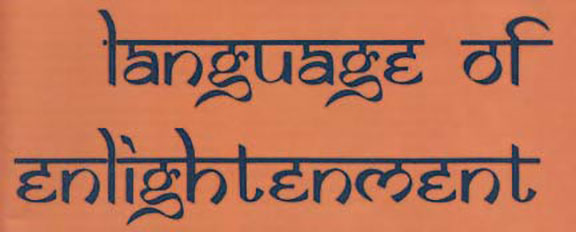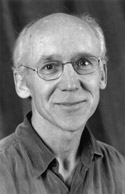 Among the many marvelous gifts of the Sanskrit language is a rich spectrum of terminology that defines with impeccable precision a world of vision and clarity that opens through Yoga and meditation. Without this, the already difficult journey to self-knowledge could be much like a trip to a mountain retreat without the benefit of a high speed vehicle traveling on roads with names.
Among the many marvelous gifts of the Sanskrit language is a rich spectrum of terminology that defines with impeccable precision a world of vision and clarity that opens through Yoga and meditation. Without this, the already difficult journey to self-knowledge could be much like a trip to a mountain retreat without the benefit of a high speed vehicle traveling on roads with names.
The chanting of Sanskrit as preparation to meditation is the vehicle. It tunes the body, mind and senses to a finer frequency and then provides the road map, ancient truths concisely stated in exacting terms that glide through the mind with a minimum of effort. The trip goes especially smoothly when absorbed in the beautiful elegance of sound, chanted aloud or whispered silently within, giving birth to meaning that points the way. Sanskrit, like anything else can turn into a commuter’s monotony, where in spite of beautiful scenery, the driver has his mind on other things. If it becomes mechanical, one can forget to look, or listen.
The definition of Yoga that appears at the beginning of Patanjali’s Yoga Sutras is a perfect example of terminology that is as technical with regard to the process of yoga meditation as the mathematical equations that define the behavior of atoms in the field of physics. For example: Yoga = citta-vrtti-nirodhah is as fundamental to Yoga as e = mc2 is to physics.
Without understanding the word “citta”, the equation can’t be grasped. There are no English equivalents for citta. To substitute an English word like “mind” or “mindstuff” makes a genuine understanding of Yoga virtually inaccessible. To leave the word citta as it is and make an enquiry into its meaning by contemplating its use throughout the Yoga Sutra text leads to meaning as rich in dimension as life itself.
Citta is the individual life field, normally defined by, but not limited to the parameters of the physical body. It consists of the purest and subtlest form of matter/energy (sattva guna). Although any form of recording, from film and tape to micro chips offers a metaphor for citta’s capacity to record the infinitely complex multidimensional experience of life, they are crude by comparison. On the one hand, it’s strange that we should be so compelled to have the finest and the fastest means of recording impressions of life through digital technology, when each of us already possesses an existing system that no advancement in technology will ever be able to duplicate. On the other hand, it’s likely that our obsession or passion for clarity and speed of reproduction is based upon our great need — to experience and utilize our own citta’s capacity in its pristine state to sense and record the finest and subtlest experience that life has to offer. This use of citta is precisely what Yoga is all about from beginning to end.
Citta is like a movie screen, in the sense that when the movie is playing we’re not aware of the screen. The difference being that while the screen remains the same size, citta can take the form of anything from the smallest particle (paramanu) to an infinite magnitude (parama-mahattva). Citta can be focused anywhere, in any location (dharana) and sustained continuously in a single location (dhyana). This means that citta can illuminate any form of matter or energy by taking its form, as if having no form of its own. This is the meaning of the Yoga term samadhi.
Citta is ever-changing. From the perspective of Yoga its changes are viewed as a progression (krama) consisting of linked moments or ksana, which measure the time it takes an atom to move from one position to the next. The beginning of citta is unknown. Its end point represents kaivalya perfect self-knowledge.
Citta is programmable. It behaves in whatever way it is programmed or habituated to behave. If it is not consciously directed it will conform to the activities (vrtti) that have shaped it in the past (vrtti-sarupyam). This is very much like a default selection.
Thus, prior to Yoga, changes in citta are programmed by habits; physical habits, mental habits, sensory habits — all of which create repetitive patterns of experience, some pleasurable, some painful, but all contributing to a limited sense of self (citta being confined to the definition of the body). It could be said that the changes occurring in citta are painfully slow. Yoga is a process of terminating the habitual activities which have been seen to be painful. This is referred to as nirodha, another term better left un-translated.
Of all the ways Patanjali could have defined Yoga , he chose the word nirodha — “Yoga is nirodha”. Nirodha is the force that continuously purifies citta. I use the word “force” in the sense of “force of habit”. Nirodha is the only force greater than that of habit — specifically the habits that perpetuate citta in a constricted and clouded state. Nirodha is the new program for citta, that prevents the old from operating and reestablishing itself. It does so by two means: 1. vigilance in keeping citta forcused (abhyasa) and 2. the full awareness of one’s own power of choice to disconnect and free oneself from the force of previous habits (vairagya).
Nothing less than the combined power of abhyasa and vairagya can establish the force of nirodha, and make it strong enough to override the complex programming of self preservation and survival, all the mechanisms an individual has developed to seemingly preserve security, repeat pleasure, avoid pain and deny an inevitable death of one’s body.
Since the old program is based on millions of years of evolution it does not quit easily. Yet, as long as I define my life by the lifetime of my body, I can’t and won’t stop brooding over my own survival plan. In order to abandon it I must see that it truly offers no hope for happiness or fulfillment. I must also have something to replace it with. Here the gift of Sanskrit along with Patanjali’s mastery in composing through that medium provides a vision of great clarity and simplicity. The work itself is a guide book that provides all the necessary insights and practices for replacing the old with the new. But more than anything, the successful installation of the Yoga model depends on understanding the concept of citta, for it is the progression of citta that ultimately replaces my former identity.
As with the body, there is an end to the sequential progress of citta. Since Yoga is the process of consciously terminating activities (vrtti) which define and limit citta, this process results in the experience of citta in a purer and purer condition. When nirodha has become the most powerful force in the progression of citta, inevitably a final nirodha takes place. When this occurs, citta is in a pristine state, so pure that it can only record its own purity. Its mission accomplished (krtartha), devoid of it’s purpose of providing a field for the Self (purusartha-shunya), citta recedes into a state of dormancy (pratiprasava) and then the power of pure awareness (citi-shakti) abides in its own essential nature. The long journey of citta is fulfilled.
The stunning contrast between the two models is that whereas in the individual survival program the end of the body is feared and held at bay, in the Yoga model, the wrapping up of the journey of citta is actively pursued, knowing that the terminal point of citta represents freedom, kaivalyam.
By Vyaas Houston, M.A.

Vyaas Houston is the founder and former director the American Sanskrit Institute. After teaching Sanskrit and Yoga for more than 15 years, he discovered in 1987 a successful method for teaching Sanskrit based on the yoga model of Patanjali’s Yoga Sutras. His Sanskrit Training has provided thousands of people with the opportunity to discover their own unique relationship with Sanskrit. Vyaas Houston is the author of Sanskrit by CD and the Sanskrit Atlas 1.0, and has recorded and translated many Sanskrit classics.


